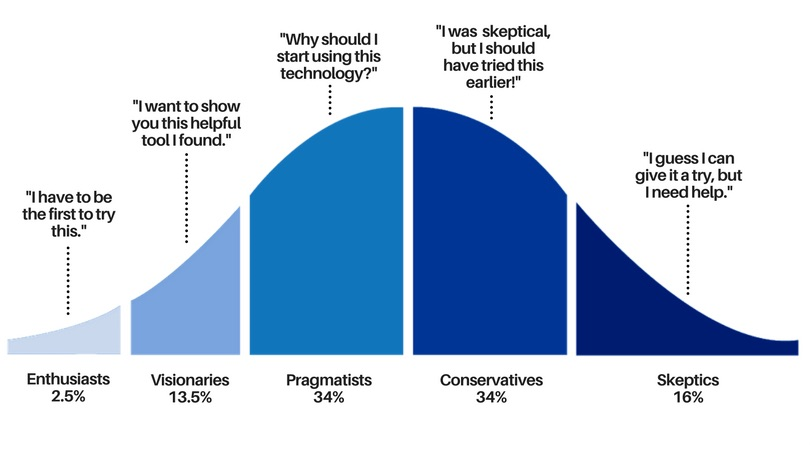The Construction and Infrastructure Technology Adoption curve changing is changing for the better.
Whenever a new technology is introduced, there are patterns in how quickly people adopt them. From the Luddites, a secret organisation of English textile workers who destroyed textile machinery, believing them to be taking away work from skilled workers, to many of us who exclaimed, “Why do I need a camera on my phone? I just want to make calls,” some people are naturally slow adopters. Others quickly jump on the latest technologies and implement them immediately; sometimes this works, think iPhone, and sometimes it doesn’t (Laserdisc!).
This pattern of behaviour is typically seen across the adoption curve and throughout the construction and infrastructure supply chain; we see similar patterns with our customers and potential customers, when we talk about how using technology can significantly improve their productivity and performance.

Typically, when we are engaging the supply chains of major contractors, the people we talk to fall into the following categories:
- The Willing - those that either have been looking or recognise the problem and embrace the solution to deliver value
- The Compliant - those that aren't looking for a solution, happy with the status quo but will do the minimum required to satisfy their client
- The Resistant - those who actively push back on the requirement to go digital and will avoid or vigorously argue about the solution’s cost or simplicity.
However, we have noticed that change is rapidly moving through the industry, perhaps spurred on by organisations such as Queensland Major Contractors Association and The Australia Constructors Association, who have advocated for greater technology adoption to improve performance and profitability, and sustainability. As detailed in the chart, the productivity metric for Construction has decreased across the period and is now sitting at similar levels to thirty years ago. Compared to other industries, particularly manufacturing, which is often listed as an example of an industry in decline, the results for construction and infrastructure do not make for the best reading.

Docketbook’s Mark Shepherd-Smith believes that there are signs of good news ahead, “The proportion of these audiences is changing as we engage with different supply chains over time. Two years ago, it was a mix of compliance and resistance. Today we see a greater willingness to consider new opportunities to utilise data to improve efficiency across areas that have previously been resistant to change. In turn, this is transitioning people along the maturity curve as we see our Docketbook network build; companies begin to influence their suppliers and partners who become adopters and create a groundswell of change, making it harder for the laggards to resist.”
“It is a fantastic example of a theory being played out in real-time across a critical industry and one that bodes well for the future. As we move through the delivery of major project pipelines across all states and look forward to the infrastructure needs of the 2032 Brisbane Olympic and Paralympic Games, this is a good sign for the construction industry. As the industry continues to embrace technology-based solutions to move information faster, which will result in better outcomes for the industry, its stakeholders and the businesses and citizens who will rely on the critical infrastructure to support economic and social activities.”
With every digital docket processed, saving around $7 versus processing paper-based dockets, Mark believes contractors and their key suppliers should embrace new technologies as soon as practicable. “We have rolled out Docketbook across Tier One Contractor’s projects, multi-national materials suppliers, fleet haulage businesses, labour hire and plant hire companies, big and small. In each instance, we have been able to demonstrate the financial, productivity, information sharing, and resourcing benefits of digital adoption, so it is time for the industry to move away from producing endless reams of printed dockets and taking on a solution that puts the power of critical information back into their own hands,” said Mark.
You can learn more about Docketbook’s solution at: https://docketbook.com.au/




